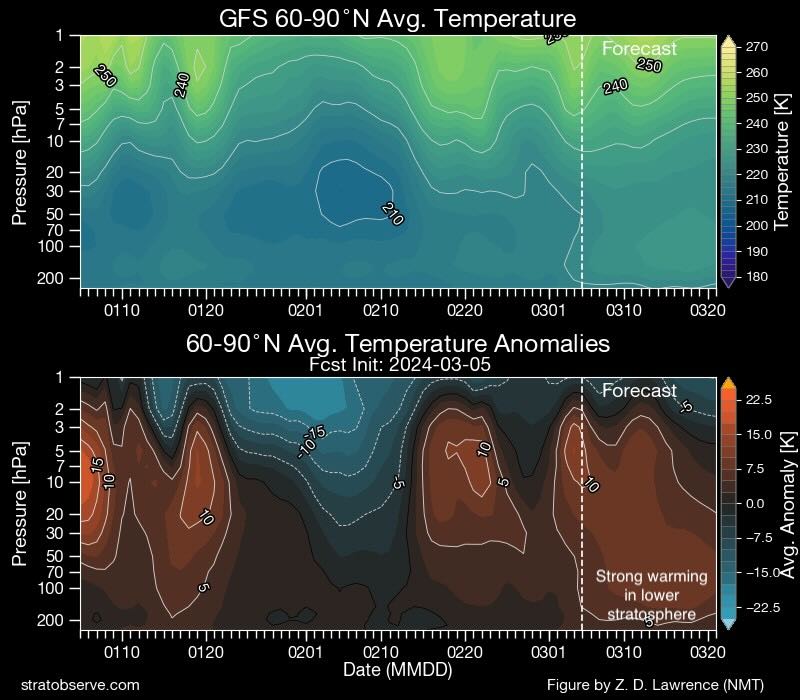Have you already noticed that the spring this year has been colder than usual? There’s an explanation for these freezing spring temperatures: a sudden stratospheric warming (SSW), which started on March 4, 2024. This phenomenon, while not directly impacting our daily weather, can have a ripple effect. Specifically, it could lead to colder and more disruptive conditions weeks or even months later.

Let’s delve into the science behind SSWs, explore their potential consequences, and understand how this specific event might influence the upcoming spring and summer seasons.
What Is Sudden Stratospheric Warming?
Our atmosphere is layered, with temperature typically increasing as we move upwards. The stratosphere, residing roughly 6 miles (10 km) to 31 miles (50 km) above the Earth’s surface, is no exception. However, during winter, a swirling mass of frigid air called the polar vortex reigns supreme in the stratosphere. This vortex acts like a high-altitude barrier, keeping the coldest air trapped around the poles.
A sudden stratospheric warming disrupts this tranquility. Powerful atmospheric waves, called planetary waves or Rossby waves, travel upwards and “break” over the polar vortex, dramatically rising stratospheric temperatures. This causes the polar vortex disruption, sometimes even reversing its wind direction. The once-contained cold air can then escape southward, potentially influencing weather patterns in the troposphere, the layer directly below the stratosphere where our daily weather happens.

Sudden stratospheric warmings happen roughly six times every ten years in the northern hemisphere. In the southern part, they happen about once every two to three decades. As of 2024, there were only 2 known sudden stratospheric warmings in the southern hemisphere.
SSW Impact on Weather: A Wavy Forecast
The influence of SSWs on tropospheric weather is complex and not guaranteed. It can take weeks or even months for the stratospheric warming effects to trickle down. The specific impacts depend on various factors, including the strength of the warming and pre-existing weather patterns. Here’s what we generally expect:
- Cold air outbreaks. The weakened polar vortex can allow frigid air to descend southward, potentially bringing cold spells to mid-latitude regions like Europe, North America, and Asia. However, it’s hard to predict the exact location and intensity of these outbreaks.
- A wobbling jet stream. The jet stream, a high-altitude band of strong winds, plays a crucial role in steering weather systems. SSWs can intensify the jet stream, creating large-scale atmospheric blocking patterns. These persistent high-pressure zones can divert warm or cold air masses from their typical paths, leading to regional temperature extremes.
 Image source: Wikipedia
Image source: Wikipedia
- Increased storminess. The contorted jet stream can also lead to increased storminess in certain areas, with the potential for stronger winds, precipitation events, and even disruptive snowstorms.
The 2024 SSW: A Glimpse into the Future?
While scientists are still analyzing the specific details of the SSW 2024, it’s important to understand the potential consequences:
Spring chill. There’s a chance that parts of the Northern Hemisphere, particularly Europe and North America, could experience a colder spring weather forecast than usual. This could delay the start of spring seasons and impact agricultural activities.
Uncertain summer. The long-term influence of sudden stratospheric warmings on the summer weather forecast is even less clear. While some studies suggest a potential for cooler summers following strong SSWs, others indicate minimal impact.
The table below summarizes the potential impacts of the sudden stratospheric warming in 2024 worldwide:
| Region | Possible Impacts |
|---|---|
| Europe | Colder than average spring, increased storminess |
| North America | Below-average spring temperatures, potential for disruptive winter storms |
| Asia | Uncertain; possible for colder and wetter conditions in some areas |
Staying Informed
It is important to remember that sudden stratospheric warming does not guarantee a harsh spring or summer. Weather forecasts rely on many factors, and atmospheric models are constantly improving in their ability to predict these complex interactions. While the sudden stratospheric warming 2024 might influence weather patterns, the exact impacts remain uncertain. Meteorologists will continue to monitor the situation and provide updates as our understanding evolves.
The March 2024 SSW reminds us of the intricate connections within our atmosphere. While the immediate consequences remain to be seen, it is still important to research these events and their potential impacts on our weather patterns. So, stay tuned for weather updates, and keep an extra sweater handy – spring and summer might just have a surprise in store.






